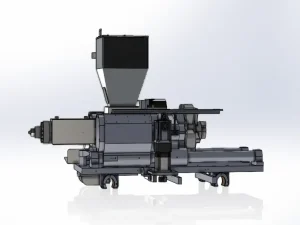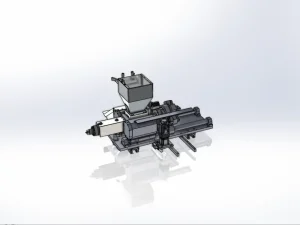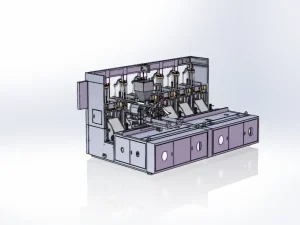The rubber injection molding process has brought massive change. It has given a new way to create accurate products quickly. You can make thousands of rubber products using this manufacturing method. It is a cost-effective solution that helps achieve 100% precision.
Everyone knows this process uses specialized injection molding machines. But no one knows about how this rubber injection process works. That’s why I’ve decided to write a dedicated article on this topic. Previously, I wrote a dedicated article on how injection molding works.
But today’s article is different. How? Because I’ll only focus on rubber injection molding. You’ll learn how to use rubber to make various products. Sounds interesting? Stay tuned as I dive into the details.
What is Rubber Injection Molding?

It is a manufacturing method that uses rubber material as raw material. The rubber undergoes heating, which converts it into a pliable or soft form. This pliable rubber is filled into the mold and allowed to solidify. Once it hardens, it adopts the shape of the mold. After this, it is ejected from the mold.
The rubber injection process is done through dedicated rubber molding machines. These machines use rubber as the primary raw material. Generally, the raw material is melted at a very high temperature. After this, the molten state of that raw material goes into the mold. Right? That’s true for plastics and metal molding.
But that’s untrue when it comes to rubber molding. Rubber is heated and changed into a very soft form. Remember, it is not melted and changed into the molten phase. This pliable form of rubber is enough to fill the mold and make the products. The usage of rubber molding has some limitations.
Wondering which rubber is used in the injection molding process? Almost all rubber types can be injection molded. However, some of them are more common than others. Their selection depends on their specific properties. Remember, each of those has its properties. Manufacturers use them as raw materials based on properties manufacturers need.
How Does the Rubber Injection Molding Process Work?

Let’s clarify the confusion. Rubber and plastic injection molding machines differ. Rubber injection molding uses rubber molding machines, and vice versa. The molding process is the same to some extent, but you’ll see some minor differences between their moldings. Let’s discuss how rubber injection molding works in simple steps.
1- Preparation of Rubber Material
This process uses rubber as the primary raw material. Manufacturers add some additives to this raw material, which give the rubber specific properties. The selection of additives depends on the manufacturers’ needs. Once the additive is mixed with rubber, the mixture undergoes heating.
Remember, the heating does not change the rubber into molten form. Instead, this heating makes a pliable form of the rubber. This is a very soft form that can be filled into the mold. This step differentiates rubber molding from plastics and metal molding processes.
Quick Highlight: The temperature at which rubber is heated varies from one type to another. Remember, each rubber type has its strength. So, it requires a specific temperature for its melting. Before using any rubber, you must know the temperature at which it becomes pliable.
2- Mold Design and Preparation
The second step is to create the mold. Remember, the design or shape of the mold is crucial for proper production. The mold must be similar to the product you want to create. Creating mold is the trickiest part of this rubber molding process. Molds generally have two halves. Between those two halves, there remains a cavity.
This place or location plays a key role. The rubber is filled in this cavity. After filling, the halves are close together, and the solidification process starts. However, you don’t have to create mold again and again. Once a mold is made, it can be used to make many products. For example, you make a mold for making rubber rings.
Once this mold is made, you can make as many rings as you want. Keep filling the mold with rubber and getting products. For the creation of molding, you should take the help of experts. Remember, slight mistakes in mold-making can be disastrous. The wrong shape of mold will cause faulty production.
Simply put, the precision and quality of the end product depend on the mold. High-end software is available for designing molds generally made of solid material. I highly recommend outsourcing this mold creation for the best results. However, if you have the skill, you can also make it by yourself, but it can result in inaccurate mold shapes.
3- Rubber Injection Process
In the first step, I mentioned heating the rubber to change it into a pliable form. This soft rubber is then filled into the mold. Remember, this filing is not straightforward. It requires a specific temperature during the filling. The purpose of this temperature is to keep the rubber soft. Why? Because filling this soft rubber in the mold would be easy.
As I said earlier, the mold has two halves. The soft rubber would go into the cavity between those halves. The injection unit fills the cavity evenly so that the end product is uniform. Remember, the machines control this injection process. There is little human effort involved in injecting rubber into the mold.
4- Cooling and Ejection
Remember, different types of rubber are used in the molding process. Each has different properties and characteristics, and their curing time can vary. Don’t you know what curing time is? It is the duration that rubber takes to solidify.
The cooling process happens at some pressure, and the temperature is generally low during this phase. Due to cooling, the rubber cools, solidifies, and adopts the shape of the mold. In this way, you get the desired product, which is precisely similar to the size and shape of the mold. After cooling, the ejection process happens.
Ejection is the last step in this rubber injection molding process. In this step, the solidified rubber product is removed from the mold. This ejection process is not very simple. Instead, it requires specific parameters for smooth ejection. A pin (ejector) remains at the bottom of the mold, which helps to eject the product from the mold.
5- Trimming & Finishing
Almost all rubber products undergo an additional process. This process trims and shaves the irregularities of the products. As I said, rubber has different types, so each can have a different level of surface roughness. The additional step of tripping gives the product a surface finish. Is this step mandatory? NO! This is an option step that enhances the overall appearance of your products.
Types of Rubber Injection Molding Processes

Rubber injection molding may seem a simple concept. But it is not! It handles the heavy load of the manufacturing industries. It has different types. Each of those has its unique value propositions. Moreover, different types of rubber undergo those different types of rubber molding. Here are some types:
- Organic Rubber Injection
- Liquid Injection Molding or LSR Injection
- Thermoplastic Rubber Injection
- Custom Rubber Injection Molding
- Rubber Compression Molding
- Rubber Transfer Molding
Organic rubber injection molding only uses organic rubber. Their molding process is the same as I mentioned above. Similarly, the liquid injection molding uses liquid silicon as a raw material. It can also use some other liquid elastomers. The thermoplastics rubber is used in the thermoplastics rubber injection molding process.
This rubber is versatile as it can be heated and reshaped repeatedly. The custom rubber injection molding method uses tailored processes. This method gives specific products with customized shapes and sizes. Rubber compression molding involves an open mold where the rubber is compressed.
Last but not least, rubber transfer molding uses a specialized chamber. The pliable rubber is first placed in the pot or special chamber. It is then forced into the mold, which is solidified to make the final product. This method helps remove defects, making the cavity filling smoother and evener.
Advantages and Disadvantages of Rubber Injection Molding
If you’ve been reading along, you know the injection molding basics. However, this topic requires more detailed information for better understanding. The section below discusses some of the pros and cons of rubber injection molding. This will help you better comprehend when to use this manufacturing method.
Advantages of Rubber Injection Molding
- This method helps in producing many products in no time. It improves efficiency and productivity.
- The products made through this method are exact. Their shape is similar to the shape of the mold.
- You can use any type of rubber to make your product. There is no restriction regarding which rubber you can use.
- This method does not waste any rubber during the injection process. The injection unit injects rubber into the mold accurately.
- This method can make any complex design of a product. All you need is to have a mold. It will give you a rubber product similar to the shape of a mold.
- This molding process gives you repeatability. This means you’ll achieve consistency in the shape and size of the products.
Disadvantages of Rubber Injection Molding
- The rubber injection molding machines are very costly. It can be an issue for small manufacturers to afford them.
- These machines have some maintenance costs. You’ll have to hire a particular laborer for its operation and maintenance.
- It may not be ideal for producing a small amount of product. Its setup would take more time. It is more suitable for bulk production.
- The vulcanization process can take more time for specific rubbers. It can make the production process a bit slow.
Applications of Rubber Injection Molding
Rubber injection molding is a helpful manufacturing process. It is used in various industries to make different products. This quick and precise process enhances its value in other sectors. Here is a list of some industries that use this method.
Moreover, I have also mentioned products made through this method that are used in those sectors.
| Industry | Applications/Products |
| Automotive | Seals, gaskets, O-rings, vibration dampers |
| Medical Devices | Catheters, seals, valves, syringe stoppers |
| Electronics | Keypads, protective seals, insulators |
| Aerospace | Seals, grommets, insulation components |
| Consumer Goods | Grips, handles, flexible parts |
Many other industries use this rubber injection molding method. Mentioning all of them is not possible in a single article. However, the above-listed industries use this method more aggressively. With this information, the decision-making about using this method would be much easier.
Conclusion
Many modern industries rely on rubber injection molding. This method helps them make complex products quickly. Moreover, it provides exceptional precision, which is another plus. In this article, I mentioned all things related to this production process. Starting from the definition and process, I discussed its types. After reading this comprehensive article, I believe their selection process will be easy.

